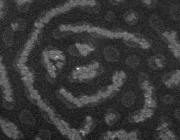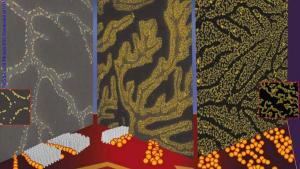Citation:
Abstract:
Simulations and experiments of nanorods (NRs) show that co-assembly with block copolymer (BCP) melts leads to the formation of a superstructure of side-to-side NRs perpendicular to the lamellar axis. A mesoscopic model is validated against scanning electron microscopy (SEM) images of CdSe NRs mixed with polystyrene-block-poly(methyl methacrylate). It is then used to study the co-assembly of anisotropic nanoparticles (NPs) with a length in the same order of magnitude as the lamellar spacing. The phase diagram of BCP/NP is explored as well as the time evolution of the NR. NRs that are slightly larger than the lamellar spacing are found to rotate and organize side-to-side with a tilted orientation with respect to the interface. Strongly interacting NPs are found to dominate the co-assembly, while weakly interacting nanoparticles are less prone to form aggregates and tend to form well-ordered configurations.





